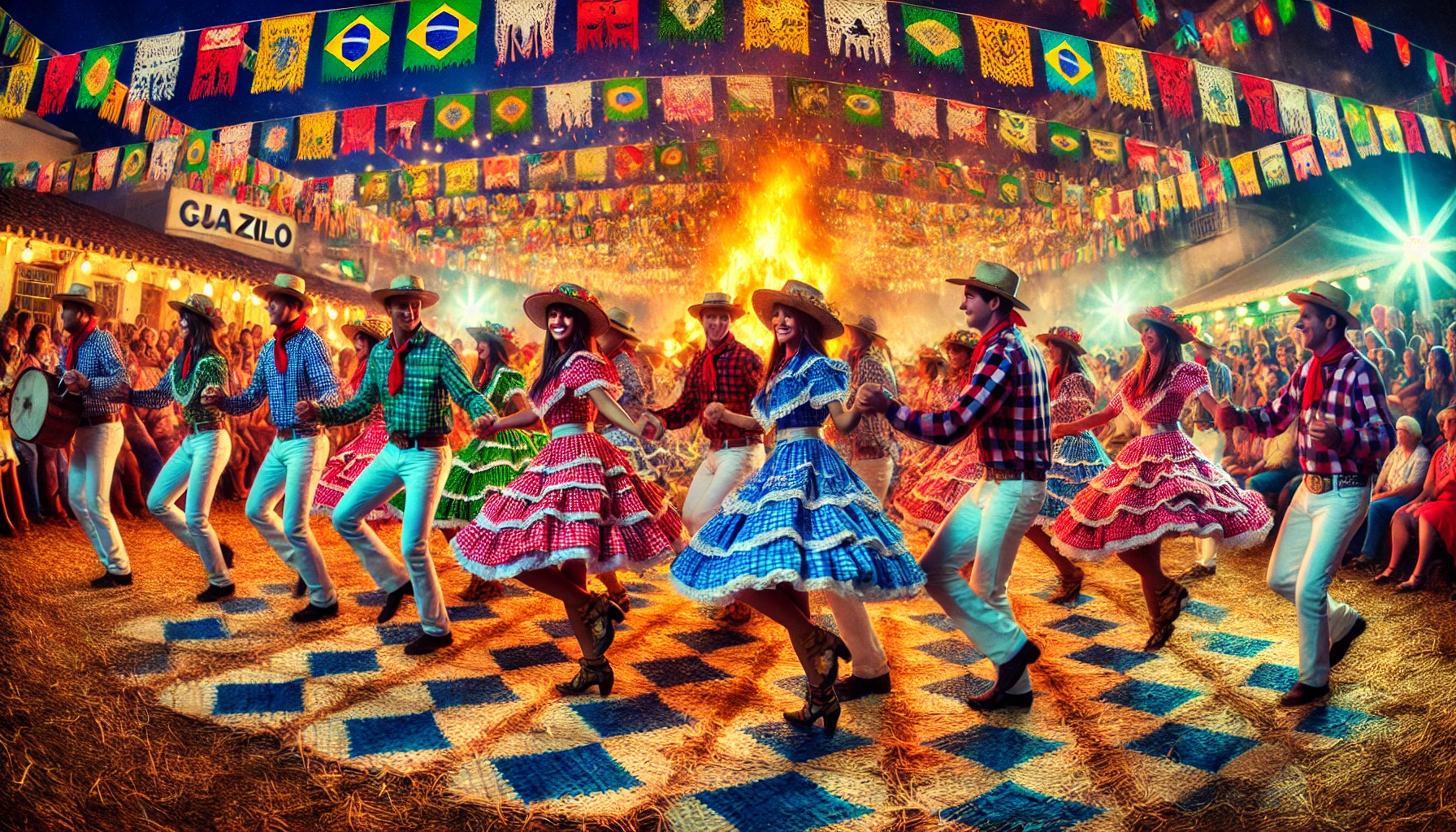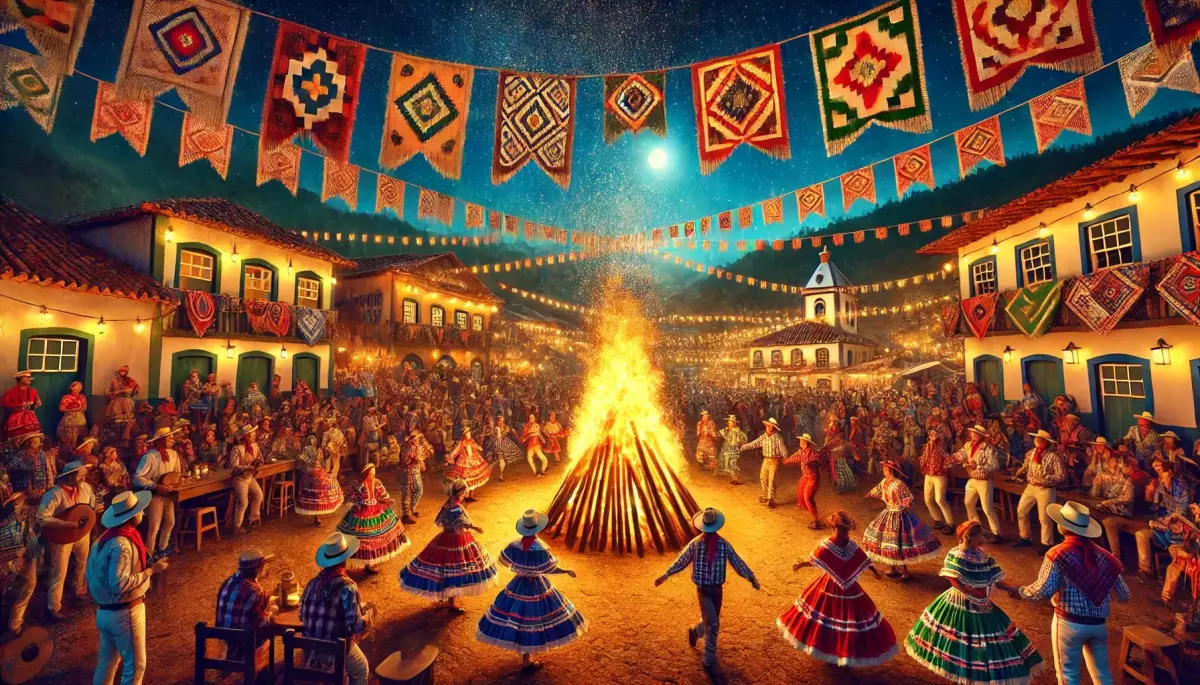Saint John's Day is one of the most emblematic festivities in Brazil, celebrated with fervor in various regions of the country. This special date refers to traditions that involve dance, music, and typical dishes, reflecting the rich Brazilian popular culture. With its bonfires, balloons, and games, the celebration becomes a moment of unity and joy among friends and family, perpetuating customs that date back to the past and adapt to the present.
The celebration of Saint John's Day is a vibrant expression of Brazilian cultural identity, uniting generations around its traditions. Thus, the festivity not only keeps the historical roots alive but also promotes a sense of belonging, strengthening community bonds. Therefore, this celebration becomes a true intangible heritage, valued by all who participate and enjoy its festivities.
Origin and History of Saint John's Day in Brazil
Saint John's Day is a celebration that dates back to religious and cultural traditions intertwined over the centuries. The festival, celebrated on June 24, has its roots in Christianity, especially in the figure of Saint John the Baptist, who, according to tradition, was born six months before Jesus Christ. In Brazil, this celebration began to gain strength with the Portuguese colonization, which brought with it various religious festivities. Thus, the June festivities became a way to honor not only the saint but also to celebrate the harvest.

In addition to the Portuguese influence, Saint John's Day is also marked by the contributions of indigenous and African cultures, which enriched local traditions. Over time, the festival transformed into an event that is not only religious but also cultural, reflecting the diversity of the Brazilian people. The celebrations spread throughout the national territory but gained special prominence in the Northeast and Central-West regions, where traditions remain more alive and authentic.
The holiday is not considered a national holiday, but it is widely celebrated in various cities, especially those that keep the June traditions alive. The festival is marked by dances, typical foods, and an atmosphere of joy and unity. Therefore, Saint John's Day is an opportunity for communities to gather and celebrate their roots, keeping alive the flame of the traditions that shaped Brazilian cultural identity.
Full Calendar of Saint John's Day until 2050
| Year | Next Date |
|---|---|
| Saint John's Day in 2025 | 06/24/2025 |
| Saint John's Day in 2026 | 06/24/2026 |
| Saint John's Day in 2027 | 06/24/2027 |
| Saint John's Day in 2028 | 06/24/2028 |
| Saint John's Day in 2029 | 06/24/2029 |
| Saint John's Day in 2030 | 06/24/2030 |
| Saint John's Day in 2031 | 06/24/2031 |
| Saint John's Day in 2032 | 06/24/2032 |
| Saint John's Day in 2033 | 06/24/2033 |
| Saint John's Day in 2034 | 06/24/2034 |
| Saint John's Day in 2035 | 06/24/2035 |
| Saint John's Day in 2036 | 06/24/2036 |
| Saint John's Day in 2037 | 06/24/2037 |
| Saint John's Day in 2038 | 06/24/2038 |
| Saint John's Day in 2039 | 06/24/2039 |
| Saint John's Day in 2040 | 06/24/2040 |
| Saint John's Day in 2041 | 06/24/2041 |
| Saint John's Day in 2042 | 06/24/2042 |
| Saint John's Day in 2043 | 06/24/2043 |
| Saint John's Day in 2044 | 06/24/2044 |
| Saint John's Day in 2045 | 06/24/2045 |
| Saint John's Day in 2046 | 06/24/2046 |
| Saint John's Day in 2047 | 06/24/2047 |
| Saint John's Day in 2048 | 06/24/2048 |
| Saint John's Day in 2049 | 06/24/2049 |
| Saint John's Day in 2050 | 06/24/2050 |
Typical Traditions and Rituals of the Celebration
The traditions of the Festa de São João are rich and varied, reflecting the cultural diversity of Brazil. One of the most common practices is the lighting of bonfires, which symbolize purification and light that drives away darkness. People often jump over the bonfires as a ritual for luck and protection. In addition, the bonfires serve as a meeting point where friends and family gather to celebrate together. The presence of the bonfire is one of the hallmarks of the June festivals, bringing a special warmth to the celebration.

Another important ritual is the quadrilha dance. This type of dance is characterized by choreographed steps and involves the participation of groups organized in pairs. The quadrilha is a form of social interaction, and the dances are often accompanied by traditional music, creating a festive and joyful atmosphere. Moreover, the typical clothing, with flared skirts and straw hats, contributes to the June vibe, making the event even more fun and visually appealing.
The Festa de São João often includes the practice of simpatias, which are popular rituals aimed at attracting luck and love. Many people tend to perform simpatias such as lighting a candle for São João or writing names on pieces of paper and placing them in a bucket of water. These rituals, which may seem simple, are a way to connect people to their beliefs and traditions, creating an atmosphere of hope and optimism during the June festivities.
Typical Foods of São João: Junina Delights
The culinary delights of the Feast of São João are one of the main attractions of the festival. The typical foods vary from region to region, but some delicacies are almost universal in the Junina celebrations. Among them, the "pamonha" stands out, a dish made from green corn, which can be prepared either sweet or savory. Another highlight is boiled corn, which is served on the cob and is a true symbol of the Junina festivals, bringing flavor and nostalgia. The presence of these foods reinforces the connection with agriculture and rural traditions.
Sweets are also protagonists in the celebrations of São João. The "pé de moleque," a candy made from peanuts and rapadura, and canjica, a dish based on corn with coconut milk, are just a few examples. These dishes not only satisfy the palate but also evoke memories of family traditions, often prepared by grandmothers and mothers. Thus, food becomes a link between generations, uniting people around recipes that have been passed down over time.
In addition to the mentioned delights, the Junina festivals also typically include traditional drinks, such as quentão and vinagrete. Quentão, a hot drink made with cachaça, ginger, and spices, is perfect for warming up the cold June nights. Vinagrete, in turn, is a salad that combines chopped vegetables and vinegar, bringing freshness to the dishes. These drinks and foods complement each other, creating a unique culinary experience that is one of the great attractions of the Feast of São João.
Parties and Quadrilhas: The Joy of Arraiais
June festivals, especially those dedicated to Saint John's Day, are known as arraiais. These events are true celebrations of popular culture, bringing together people of all ages in a festive environment. Arraiais usually take place in public squares or community areas, where stalls with typical foods, games, and recreational activities are set up. The atmosphere is filled with joy, with music and dances that enliven the participants, creating a sense of community and belonging.
The quadrilha, as mentioned earlier, is a central element of June festivals. Unlike other folk dances, the quadrilha is a group dance that involves coordinated steps and interaction between partners. People dress in typical clothes, such as chita dresses and checkered shirts, adding a special charm to the performance. The spirit of healthy competition is also a striking feature, as many quadrilhas compete against each other for prizes, which further elevates the festive mood.
In addition to the dances, the arraiais often include a variety of popular games, such as the ring toss and fishing games. These activities are a fun way to entertain both children and adults. The interaction among participants, combined with lively music and dances, creates a vibrant and welcoming environment. The highlight of the June festivals, therefore, is a collective celebration that reinforces social and cultural ties among participants, making Saint John's Day a moment of pure joy.
Conclusion
Saint John's Day is a celebration rich in traditions that reflects the cultural diversity of Brazil. This special date not only brings families together around typical foods and dances but also recovers historical and folkloric elements that strengthen national identity. Thus, the festivities go beyond mere entertainment, promoting a sense of belonging and appreciation of cultural roots.
Moreover, the commemorative event stands out for its ability to unite communities, creating an environment of fellowship and joy. The celebrations, which include bonfires, balloons, and quadrilhas, are a form of expression that keeps past traditions alive. Consequently, Saint John's Day becomes a symbol of cultural resistance and celebration of life.
Finally, it is essential to recognize the importance of Saint John's Day in the Brazilian context. This celebration is not just a party, but a means of revitalizing customs and strengthening social bonds. Thus, each year, as we celebrate this date, we reaffirm our commitment to preserving culture and celebrating our roots. Therefore, Saint John's Day remains an essential pillar of Brazilian cultural identity.
